 W
WThe Gospel according to Matthew, also called the Gospel of Matthew, or simply Matthew, is the first book of the New Testament and one of the three synoptic Gospels. It tells how Israel's Messiah, rejected and executed in Israel, pronounces judgement on Israel and its leaders and becomes the salvation of the gentiles. The gospel reflects the struggles and conflicts between the evangelist's community and the other Jews, particularly with its sharp criticism of the scribes and Pharisees: before the Crucifixion they are referred to as Israelites, the honorific title of God's chosen people; after it, they are called simply Ioudaioi ("Jews"), a sign that through their rejection of the Christ the "Kingdom of Heaven" has been taken away from them and given instead to the church.
 W
WThe baptism of Jesus by John the Baptist is a major event in the life of Jesus which is described in three of the gospels: Matthew, Mark and Luke. It is considered to have taken place at Al-Maghtas, located in Jordan.
 W
WThe Beatitudes are eight blessings recounted by Jesus in the Sermon on the Mount in the Gospel of Matthew. Each is a proverb-like proclamation, without narrative. Four of the blessings also appear in the Sermon on the Plain in the Gospel of Luke, followed by four woes which mirror the blessings.
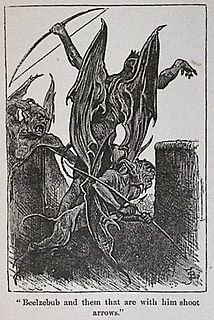 W
WBeelzebub or Beelzebul is a name derived from a Philistine god, formerly worshipped in Ekron, and later adopted by some Abrahamic religions as a major demon. The name Beelzebub is associated with the Canaanite god Baal.
 W
WThe Birds of Heaven is a discourse given by Jesus as recorded in the Gospels of Matthew and Luke in the New Testament. The discourse makes several references to the natural world: ravens, lilies and moths are all mentioned.
 W
WThe blood curse refers to a New Testament passage from the Gospel of Matthew, which describes events taking place in Pilate's court before the crucifixion of Jesus and specifically the apparent willingness of the Jews to accept liability for Jesus' death.
 W
WMatthew 10 is the tenth chapter in the Gospel of Matthew in the New Testament section of the Christian Bible. Matthew 10 comes after Jesus had called some of his disciples and before the meeting with the disciples of John the Baptist. This section is also known as the Mission Discourse or the Little Commission, in contrast to the Great Commission. The Little Commission is directed specifically to the Jewish believers of the early church, while the Great Commission is to all nationalities. The Pulpit Commentary suggests that Jesus' message in this discourse "was hardly likely to have been remembered outside Jewish Christian circles".
 W
WThe coin in the fish's mouth is one of the miracles of Jesus, recounted in the Gospel of Matthew 17:24–27.
 W
WThe Coming Persecutions, Matthew 10:16-23, is part of Jesus’ speech of commission to his disciples. Immediately preceding these verses, he had commissioned them to evangelize the Israelites with his authority. As soon as he did this, he moved to telling them of the persecutions they will be subjected to for him, before moving to a description of the world in light of their teaching.
 W
WEcce homo are the Latin words used by Pontius Pilate in the Vulgate translation of the Gospel of John, when he presents a scourged Jesus Christ, bound and crowned with thorns, to a hostile crowd shortly before his Crucifixion. The original New Testament Greek: "ἰδοὺ ὁ ἄνθρωπος", romanized: "idoú ho ánthropos", is rendered by most English Bible translations, e.g. Douay-Rheims Bible and King James Version, as "behold the man". The scene has been widely depicted in Christian art.
 W
WThe Exorcism of the Syrophoenician woman's daughter is one of the miracles of Jesus in the Gospels and is recounted in the Gospel of Mark in Chapter 7 and in the Gospel of Matthew in Chapter 15. In Matthew, the story is recounted as the healing of a Canaanite woman's daughter. According to both accounts, Jesus exorcised the woman's daughter whilst travelling in the region of Tyre and Sidon, on account of the faith shown by the woman.
 W
WFeeding the multitude is a term used to refer to two separate miracles of Jesus reported in the Gospels.
 W
W"Fishers of men" is a phrase used in the gospels to describe the mandate given by Jesus to his first disciples. Two brother fishermen, Simon called Peter and Andrew, were casting a net into the Sea of Galilee. As he commenced his preaching ministry, Jesus called them to follow him and told them that in doing so they were to become "fishers of men".
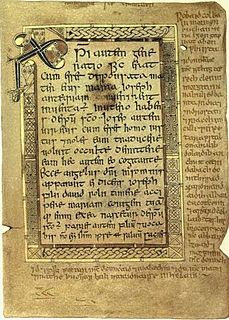 W
WIn Christianity, the term Five Discourses of Matthew refers to five specific discourses by Jesus within the Gospel of Matthew.
 W
WThe flight into Egypt is a story recounted in the Gospel of Matthew and in New Testament apocrypha. Soon after the visit by the Magi, an angel appeared to Joseph in a dream telling him to flee to Egypt with Mary and the infant Jesus since King Herod would seek the child to kill him. The episode is frequently shown in art, as the final episode of the Nativity of Jesus in art, and was a common component in cycles of the Life of the Virgin as well as the Life of Christ. Within the narrative tradition, iconic representation of the "Rest on the Flight into Egypt" developed after the 14th century.
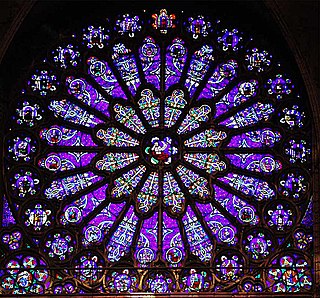 W
WThe New Testament provides two accounts of the genealogy of Jesus, one in the Gospel of Matthew and another in the Gospel of Luke. Matthew starts with Abraham, while Luke begins with Adam. The lists are identical between Abraham and David, but differ radically from that point. Matthew has twenty-seven generations from David to Joseph, whereas Luke has forty-two, with almost no overlap between the names on the two lists. Notably, the two accounts also disagree on who Joseph's father was: Matthew says he was Jacob, while Luke says he was Heli.
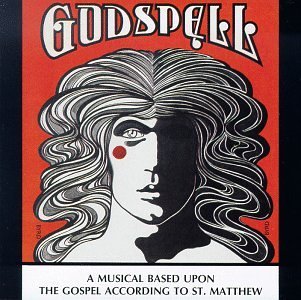 W
WGodspell is a musical composed by Stephen Schwartz with the book by John-Michael Tebelak. The show opened Off-Broadway on May 17, 1971, and has since been produced by multiple touring companies and in many revivals. The 2011 revival played on Broadway from October 13, 2011, through June 24, 2012.
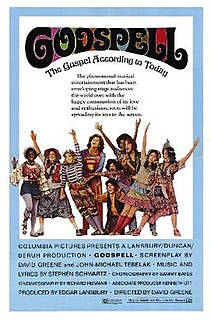 W
WGodspell is a 1973 musical film. It is a film adaptation of the 1971 Off-Broadway musical Godspell, created by John-Michael Tebelak with music and lyrics by Stephen Schwartz. Directed by David Greene with stars Victor Garber as Jesus and David Haskell as Judas/John the Baptist, the film is set in contemporary New York City. Tebelak is credited as co-writer of the screenplay and served as the creative consultant, although director David Greene said Tebelak did not write the screenplay.
 W
WThe Gospel According to St. Matthew is a 1964 Italian biblical drama film in the neorealist style, written and directed by Pier Paolo Pasolini. It is a cinematic rendition of the story of Jesus according to the Gospel of Matthew, from the Nativity through the Resurrection. The dialogue is taken directly from the Gospel of Matthew, as Pasolini felt that "images could never reach the poetic heights of the text." He reportedly chose Matthew's Gospel over the others because he had decided that "John was too mystical, Mark too vulgar, and Luke too sentimental."
 W
WThe Gospel riots, which took place on the streets of Athens in November 1901, were primarily a protest against the publication in the newspaper Akropolis of a translation into modern spoken Greek of the gospel of St Matthew, although other motives also played a part. The disorder reached a climax on 8 November, "Black Thursday", when eight demonstrators were killed.
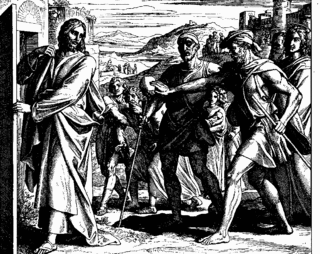 W
WJesus healing two blind men is a miracle attributed to Jesus in the Gospel of Matthew. It follows immediately on the account of the Daughter of Jairus.
 W
WImmanuel is a Hebrew name which appears in the Book of Isaiah (7:14) as a sign that God will protect the House of David.
 W
WJesus exorcising a mute is the last of a series of miracles of Jesus recorded in chapter 9 of the Gospel of Matthew. It appears in Matthew 9:32–34, immediately following the account of Christ healing two blind men.
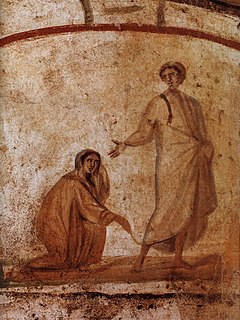 W
WJesus healing the bleeding woman is one of the miracles of Jesus in the Gospels.
 W
WJesus walking on the water is depicted as one of the miracles of Jesus recounted in the New Testament. There are accounts of this event in the gospels of Matthew, Mark, and John, but it is not included in the Gospel of Luke. This story, following the miracle of the feeding of the five thousand, tells how Jesus sent the disciples by ship back to the "other side" of the Sea of Galilee while he remained behind, alone, to pray. Night fell and the sea arose as the ship became caught in a wind storm. After rowing against the wind for most of the night, the disciples saw Jesus walking on the water. They were frightened, thinking that they were seeing a spirit, but when Jesus told them not to be afraid, they were reassured. After Jesus entered the ship, the wind ceased, and they arrived at land.
 W
WJesus' teachings referring to little children and infants/babies appear in several places in the New Testament and in the non-canonical Gospel of Thomas.
 W
W"Live by the sword, die by the sword" is a proverb in the form of a parallel phrase, derived from the Gospel of Matthew : "Then said Jesus unto him, Put up again thy sword into his place: for all they that take the sword shall perish with the sword."
 W
WThe Lord's Prayer, also called the Our Father, is a central Christian prayer which, according to the New Testament, Jesus taught as the way to pray:Pray then in this way ... When you pray, say ...
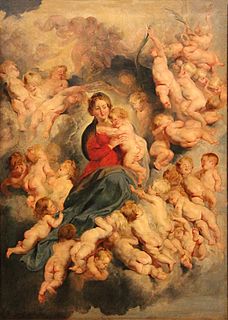 W
WIn the New Testament, the Massacre of the Innocents is the incident in the nativity narrative of the Gospel of Matthew (2:16–18) in which Herod the Great, king of Judea, orders the execution of all male children two years old and under in the vicinity of Bethlehem. A majority of Herod biographers, and "probably a majority of biblical scholars," hold the event to be myth, legend, or folklore. The Catholic Church regards them as the first Christian martyrs, and their feast – Holy Innocents Day – is celebrated on 28 December.
 W
WThe nativity of Jesus, nativity of Christ, birth of Christ or birth of Jesus is described in the Biblical gospels of Luke and Matthew. The two accounts agree that Jesus was born in Bethlehem in Judea, his mother Mary was betrothed to a man named Joseph, who was descended from King David and was not his biological father, and that his birth was caused by divine intervention.
 W
WThe Nativity is a 1978 American made-for-television biographical drama film starring Madeleine Stowe as Mary, set around the Nativity of Jesus and based on the accounts in the canonical Gospels of Matthew and Luke, in the apocryphal gospels of Pseudo-Matthew and James, and in the Golden Legend. It was directed by Bernard L. Kowalski, written by Morton S. Fine and Millard Kaufman, and filmed in Almería, Spain.
 W
WThis is a parable of Jesus which appears in Matthew 13:47–52 and refers to the final judgment. This parable is the seventh and last in Matthew 13, which began with the parable of the Sower. It directly follows the Parable of the Pearl, which is about the Kingdom of God. Thus, it links the Kingdom of God with the final judgment—the separation for hell and heaven. Jesus told the parable to his disciples.
 W
WThe Parable of the Hidden Treasure is a well known parable of Jesus, which appears in Matthew 13:44, and illustrates the great value of the Kingdom of Heaven. It immediately precedes the parable of the Pearl, which has a similar theme. The parable has been depicted by artists such as Rembrandt.
 W
WThe Parable of the Pearl is one of the parables of Jesus. It appears in Matthew 13:45–46 and illustrates the great value of the Kingdom of Heaven.
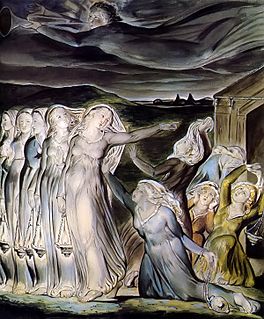 W
WThe Parable of the Ten Virgins, also known as the Parable of the Wise and Foolish Virgins or the Parable of the ten bridesmaids, is one of the parables of Jesus. According to Matthew 25:1-13, ten virgins await a bridegroom; five have brought enough oil for their lamps for the wait, while the oil of the other five runs out. The five virgins who are prepared for the bridegroom's arrival are rewarded, while the five who went to buy further oil missed the bridegrooms arrival and are disowned.
 W
WThe Parable of the Two Sons is a parable told by Jesus in the New Testament, found in Matthew. It contrasts the tax collectors and prostitutes who accepted the message taught by John the Baptist with the "religious" people who did not.
 W
WThe Parable of the Unforgiving Servant is a parable of Jesus which appears in the Gospel of Matthew. According to Matthew 18:21–35 it is important to forgive others as we are forgiven by God, as illustrated by the negative example of the unforgiving servant.
 W
WThe Parable of the Wise and the Foolish Builders, is a parable of Jesus appearing in the Gospel of Matthew and Luke.
 W
WThe Parable of the Workers in the Vineyard is a parable of Jesus which appears in the Chapter 20 of the Gospel of Matthew in the New Testament.
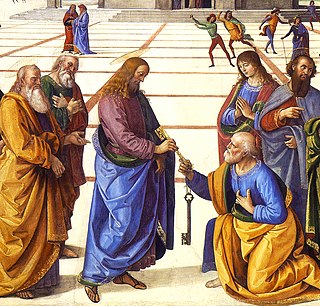 W
WThe primacy of Peter, also known as Petrine primacy, is the position of preeminence that is attributed to Saint Peter among the Twelve Apostles.
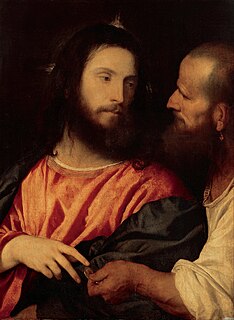 W
W"Render unto Caesar" is the beginning of a phrase attributed to Jesus in the synoptic gospels, which reads in full, "Render unto Caesar the things that are Caesar's, and unto God the things that are God's".
 W
WThe return of the family of Jesus to Nazareth, also known as the Return from Egypt, appears in the reports of the early life of Jesus given in the Canonical gospels. Both of the gospels which describe the nativity of Jesus agree that he was born in Bethlehem and then later moved with his family to live in Nazareth. The Gospel of Matthew describes how Joseph, Mary, and Jesus went to Egypt to escape from Herod the Great's slaughter of the baby boys in Bethlehem. Matthew does not mention Nazareth as being the previous home of Joseph and Mary; he says that Joseph was afraid to go to Judea because Herod Archelaus was ruling there and so the family went to Nazareth instead. The Gospel of Luke, on the other hand, does not record anything about the flight to Egypt, but says that Joseph had been previously living in Nazareth, and returned there after the Presentation of Jesus at the Temple.
 W
WSaint Joseph's dreams are four dreams described in the Gospel of Matthew in the New Testament in which Joseph, the legal father of Jesus, is visited by an angel of the Lord and receives specific instructions and warnings of impending danger. All four dreams come from the period around the Nativity of Jesus and his early life, between the onset of Mary's pregnancy and the family's return from the Flight to Egypt. They are often distinguished by numbers as "Joseph's first dream" and so on. Especially in art history, the first may be referred to as the Annunciation to Joseph.
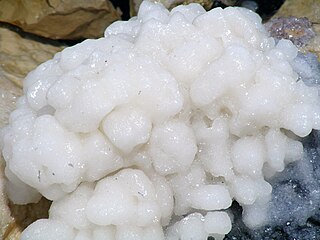 W
WSalt and light are images used by Jesus in the Sermon on the Mount, one of the main teachings of Jesus on morality and discipleship. These images in Matthew 5:13, 14, 15 and 16 immediately follow the Beatitudes and are often interpreted as referring to Jesus' expectations of his disciples.
 W
WShem Tob's Hebrew Gospel of Matthew is the oldest extant Hebrew version of the Gospel of Matthew. It was included in the 14th-century work Eben Boḥan by the Spanish Jewish Rabbi Shem-Tov ben Isaac ben Shaprut. George Howard has argued that Shem Tov's Matthew comes from a much earlier Hebrew text that was later translated into Greek and other languages. A characteristic feature of this Hebrew gospel is the appearance in 20 places of השם, in the abbreviated form ה״, where the Gospel of Matthew has Κύριος.
 W
WSon of man came to serve refers to a specific episode in the New Testament. In the Gospel of Matthew 20:20–28 and the Gospel of Mark 10:35–45, Jesus explains that he "came as Son of man to give his life as ransom". The ransom paid by the Son of man is an element of a common doctrine of atonement in Christianity.
 W
WThe St Matthew Passion, BWV 244, is a Passion, a sacred oratorio written by Johann Sebastian Bach in 1727 for solo voices, double choir and double orchestra, with libretto by Picander. It sets chapters 26 and 27 of the Gospel of Matthew to music, with interspersed chorales and arias. It is widely regarded as one of the greatest masterpieces of classical sacred music. The original Latin title Passio Domini nostri J.C. secundum Evangelistam Matthæum translates to "The Passion of our Lord J[esus] C[hrist] according to the Evangelist Matthew".
 W
WThe Star of Bethlehem, or Christmas Star, appears only in the nativity story of the Gospel of Matthew where "wise men from the East" (Magi) are inspired by the star to travel to Jerusalem. There, they meet King Herod of Judea, and ask him:Where is He who has been born King of the Jews? For we have seen His star in the East and have come to worship Him.
 W
W"Sufficient unto the day is the evil thereof" is an aphorism which appears in the Sermon on the Mount in the Gospel of Matthew chapter 6 — Matthew 6:34.
 W
WThe Exorcism of the Syrophoenician woman's daughter is one of the miracles of Jesus in the Gospels and is recounted in the Gospel of Mark in Chapter 7 and in the Gospel of Matthew in Chapter 15. In Matthew, the story is recounted as the healing of a Canaanite woman's daughter. According to both accounts, Jesus exorcised the woman's daughter whilst travelling in the region of Tyre and Sidon, on account of the faith shown by the woman.
 W
WThe temptation of Christ is a biblical narrative detailed in the gospels of Matthew, Mark and Luke. After being baptized by John the Baptist, Jesus was tempted by the devil for 40 days and nights in the Judaean Desert. During this time, Satan came to Jesus and tried to tempt him. Jesus having refused each temptation, Satan then departed and Jesus returned to Galilee to begin his ministry. During this entire time of spiritual battle, Jesus was fasting.
 W
WTextual variants in the Gospel of Matthew are the subject of the study called textual criticism of the New Testament. Textual variants in manuscripts arise when a copyist makes deliberate or inadvertent alterations to a text that is being reproduced. An abbreviated list of textual variants in this particular book is given in this article below.
 W
WThe Parable of the Weeds is a parable of Jesus which appears in Matthew 13:24–43. The parable relates how servants eager to pull up weeds were warned that in so doing they would root out the wheat as well and were told to let both grow together until the harvest. Later in Matthew, the weeds are identified with "the children of the evil one", the wheat with "the children of the Kingdom", and the harvest with "the end of the age". A shorter, compressed version of the parable is found without any interpretation in the apocryphal Gospel of Thomas.
 W
WThe three-source hypothesis is a candidate solution to the synoptic problem. It combines aspects of the two-source hypothesis and the Farrer hypothesis. It states that the Gospel of Matthew and the Gospel of Luke used the Gospel of Mark and a sayings collection as primary sources, but that the Gospel of Luke also used the Gospel of Matthew as a subsidiary source. The hypothesis is named after the three documents it posits as sources, namely the sayings collection, the Gospel of Mark, and the Gospel of Matthew.
 W
WTurning the other cheek is a phrase in Christian doctrine from the Sermon on the Mount that refers to responding to injury without revenge and allowing more injury. This passage is variously interpreted as commanding nonresistance, Christian pacifism, or nonviolence on the part of the victim.
 W
WThe two-source hypothesis is an explanation for the synoptic problem, the pattern of similarities and differences between the three Gospels of Matthew, Mark, and Luke. It posits that the Gospel of Matthew and the Gospel of Luke were based on the Gospel of Mark and a hypothetical sayings collection from the Christian oral tradition called Q.
 W
WThe virgin birth of Jesus is the doctrine that Jesus was conceived and born by his mother Mary through the power of the Holy Spirit and without sexual intercourse with her husband Joseph. The Orthodox churches accept it as authoritative by reason of its inclusion in the Nicene Creed, the Catholic church likewise holds it authoritative for faith through the Apostles' Creed as well as the Nicene, and Protestants regard it as an explanation of the mixture of the human and divine natures of Jesus; but although it has clear scriptural backing in two gospels, the consensus of modern scholars is that its historical foundations are very flimsy.
 W
WThe Visual Bible: Matthew is a 1993 film portraying the life of Jesus as it is found in the Gospel of Matthew. The complete Gospel is presented word-for-word based on the New International Version of the Bible. It was directed by South African film maker Regardt van den Bergh and stars veteran actor Richard Kiley in the role of St. Matthew, newcomer Bruce Marchiano as Jesus, and Gerrit Schoonhoven as Peter. Marchiano portrays Jesus as a joyous, earthy, personal man with a sense of humour.
 W
W